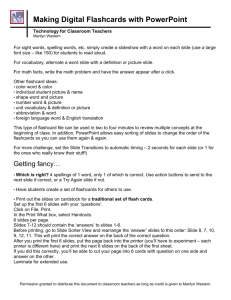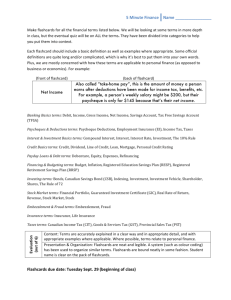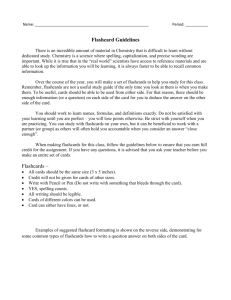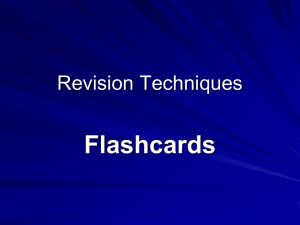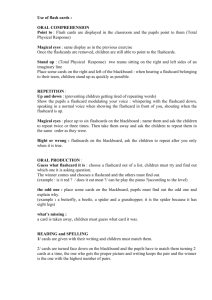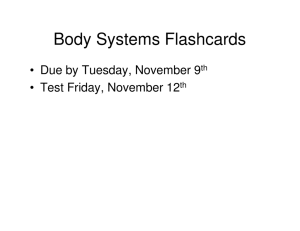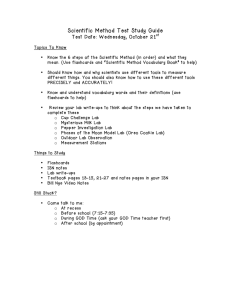flashcards - Darke County Education Service Center
advertisement
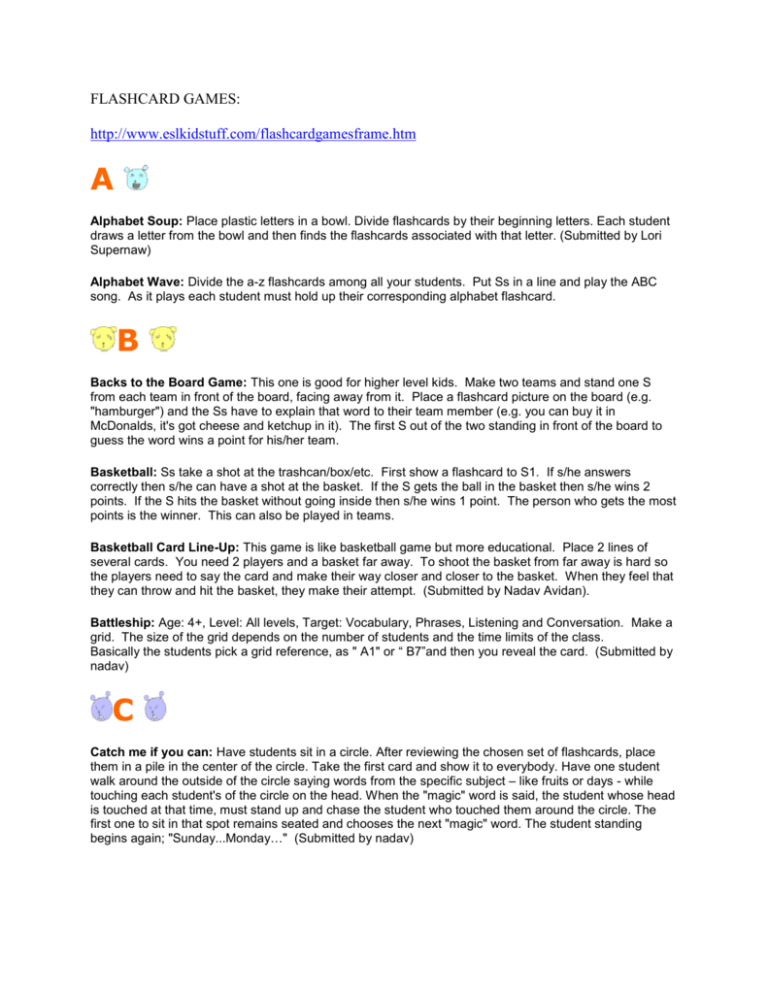
FLASHCARD GAMES: http://www.eslkidstuff.com/flashcardgamesframe.htm A Alphabet Soup: Place plastic letters in a bowl. Divide flashcards by their beginning letters. Each student draws a letter from the bowl and then finds the flashcards associated with that letter. (Submitted by Lori Supernaw) Alphabet Wave: Divide the a-z flashcards among all your students. Put Ss in a line and play the ABC song. As it plays each student must hold up their corresponding alphabet flashcard. B Backs to the Board Game: This one is good for higher level kids. Make two teams and stand one S from each team in front of the board, facing away from it. Place a flashcard picture on the board (e.g. "hamburger") and the Ss have to explain that word to their team member (e.g. you can buy it in McDonalds, it's got cheese and ketchup in it). The first S out of the two standing in front of the board to guess the word wins a point for his/her team. Basketball: Ss take a shot at the trashcan/box/etc. First show a flashcard to S1. If s/he answers correctly then s/he can have a shot at the basket. If the S gets the ball in the basket then s/he wins 2 points. If the S hits the basket without going inside then s/he wins 1 point. The person who gets the most points is the winner. This can also be played in teams. Basketball Card Line-Up: This game is like basketball game but more educational. Place 2 lines of several cards. You need 2 players and a basket far away. To shoot the basket from far away is hard so the players need to say the card and make their way closer and closer to the basket. When they feel that they can throw and hit the basket, they make their attempt. (Submitted by Nadav Avidan). Battleship: Age: 4+, Level: All levels, Target: Vocabulary, Phrases, Listening and Conversation. Make a grid. The size of the grid depends on the number of students and the time limits of the class. Basically the students pick a grid reference, as " A1" or “ B7”and then you reveal the card. (Submitted by nadav) C Catch me if you can: Have students sit in a circle. After reviewing the chosen set of flashcards, place them in a pile in the center of the circle. Take the first card and show it to everybody. Have one student walk around the outside of the circle saying words from the specific subject – like fruits or days - while touching each student's of the circle on the head. When the "magic" word is said, the student whose head is touched at that time, must stand up and chase the student who touched them around the circle. The first one to sit in that spot remains seated and chooses the next "magic" word. The student standing begins again; "Sunday...Monday…" (Submitted by nadav) Charades: Have a S come to the front of the class and show a FC or whisper a word to that S. The S then acts out that word and the first S to guess can be the next player. This works very well with action verbs. Variation: divide the class up into teams - the first S to guess wins a point for his/her team. Concentration: You need 2 sets of flashcards for this game. Place both sets face down on the floor. Ss take turns in turning over 2 cards (saying the cards aloud). If the cards match then the S keeps the cards. If the cards are different the cards are turned back over again in their original places. The S with the most pairs at the end of the game is the winner. Concentration 2: Level: requires basic reading. Make a set of cards. On half of them put a picture of a theme related subject (for example body parts, food, furniture etc) on the other half put the word relating to each picture (ex. nose, mouth, lips, eye...). Laminate if possible. Place all cards face down on the table. The first player turns two at a time (or three for the very young) over to match the word to the picture. If it matches the player can keep the pair if not, the cards are returned and then next player goes. These cards can also be used so that a child or team simply matches the words to the pictures. (Submitted by nadav) Cross the River: Place flashcards on floor in winding manner. Each represents a stepping stone in the river, as students must say word/phrase/question/etc in order to step on it and cross the river! (submitted by Michelle K). D E Easy Hard: You need at least 20 cards to play which you divide into 2 piles face down: An Easy and a Hard pile. Give each team 50 points from beginning. Pick a student and ask if they would like an easy or a hard card, also ask how many points they would like to risk on knowing the answer:Easy 1-5 and Hard 5-10. (Submitted by nadav) F Fish: Before this game you need to have the students in pairs draw and cut out a picture of a fish for each pair. While they are doing that put 2 parallel lines of tape on the floor a few meters apart. Have Ss play in twos - each student behind a different line. T shows S1 a flashcard and asks what it is. If the S answers it correctly s/he can blow once to propel the fish forward. Next, T asks S2. The S who blows the fish over the tapped line is the winner. Flashcard Fun: Hold up a flashcard and elicit the answer from a S. Ss can win the flashcard if they answer correctly. The S with the most flashcards at the end is the winner. G Give Me Game: You can use with flashcards or objects. Elicit the different flashcards you have. Then place all the flashcards around the classroom. Once the Ss have collected the flashcards (they'll probably do their best to hide them in their pockets, etc.) T says "Give me a (bus)". The S with the (bus) flashcard should approach the T and hand it to him/her: "Here you are". Avoid having the flashcards thrown back to you as they can go anywhere and takes a long time to finish this game. H Hint Animal Game: Well I tried this activity once and the children really loved it, so I kept doing it. As a review on animals cards, hold some cards without showing any. Then tell the kids that they are going to receive 3 hints, so they need to listen carefully. For example: 1. I am yellow. 2. I have long hair. 3. I am strong. Who am I? Well, a lion of course! You can make it in deferent levels depending on how much English you use or which vocab you use. (Submitted by Nadav Avidan). I J Jump On It: Spread out flashcards on the floor and have Ss stand at one end of the room. Shout out a card and the Ss have to find the card and jump on it. The first S to do this wins a point. Variation: Make 2 teams for a relay race. The first 2 Ss try and jump on the flashcard first to win a point for their team. K Karuta: Lay flashcards on a table or the floor, picture side up. Teacher calls out the word/phrase/etc. and students compete to be the first person to grab or touch the card. If they touch it, they keep it. Game continues until all cards have been picked up. (Submitted by Blythe Musteric) L Lightning Flashcards: T stands at front of class with flashcards. Ss form two teams standing in a line. Two Ss go first and face away from the T, T says 1.2.3. what is it? and Ss quickly turn around and the first S to call out the correct answer wins a point for their team (good for review of vocab). (Submitted by Laurie Pich) Line True or False: Put a line of tape on the floor and designate one side "True" and the other "False". Hold up a flashcard or object and say its word. If Ss think the you have said the correct word they jump on the True side, if not they jump on the False side. Incorrect Ss sit out until the next game. M Musical Flashcards: Ss walk around some flashcards in a circle as some music is playing. When the music stops T shouts out a flashcard and the Ss must race to step on that card. The first S to step on it keeps the card (1 point) and the game continues. Musical Chair Alphabet: Place chairs in the form of musical chairs with alphabet flashcards placed on them. Start the music when the music stops the students pick up their flashcards and have to read the sound on the flashcard. The child who is unable to read is out of the game. (Submitted by Farah Najam) N O Ostrich Game: This game is really good fun. You need some clothes pegs. Pair up Ss and peg a card onto each S's back. Both Ss face each other with hands behind backs waiting for T to shout "Go!". At this point they must try to discover his/her partner's hidden flashcard without letting their partner see theirs. When the S finally sees his/her partner's card s/he has to shout it out to become the winner. The Ss look like ostriches when playing this game. P Pass: Sit the Ss with you in a circle. T holds up a flashcard or object and says its name (e.g. "Pen"). T passes it on to the next S who also says its name and passes it on to the next S. Variations: change directions, speed rounds, have many objects going round at the same time. Pictionary: Good for reviewing vocab. Pick a S and show him/her a flashcard picture or whisper a word into his/her ear. The S draws the picture on the board and the first S to guess the picture gets to draw the next picture. This can also be played in teams with a point system. Picture Recognition Game: Have all the Ss stand at one end of the room and the T in the middle. Hold up one picture flashcard and Ss come forward and whisper the word in the T's ear. If correct they can go over to the other side of the room. Ss can have as many guesses as they like. Q Quick Peek: T holds a flashcard with the picture facing towards him/her. T quickly shows it to the Ss for a quick peek. The S who guesses the card wins a point. R Race Track: Lay out the flashcards like a race track with a start and finish line. Ss play in pairs or teams. S1 rolls a dice and moves a counter along the track. The S must say the flashcard landed on and if wrong must move back to the original position. Variation: put in some 'throw again' cards (e.g. brightly colored cards) and a nominate a 'crash' number on the die (e.g. if Ss throws a 6 they crash and must stay where they are and miss a turn). Rope Jump: you need a rope for this one! Have Ss stand behind each other in a line. Hold a rope (have a S hold the other end) at a height that the Ss should be able to jump over. On the other side of the rope spread out some flashcards or objects and a box. Call out the name of one of the flashcards/objects to the first S. S/he has to jump over the rope, pick up the correct flashcard and put it in the box. For other rounds you can hold the rope down low, so Ss have to crawl/roll under. S Shopping: This can be used with a wide range of flashcards (food pictures work well). Gather all the Ss and show them all the flashcards you have. Ask a S "What do you want?" (or maybe "What would you like?" to higher levels). The S should reply (e.g. "a hamburger, please"). T then says "Here you are" and the S finishes with "Thank you". At the end collect the objects by playing the 'Give Me' game. Slam: Sit the Ss in a circle and place some flashcards in the middle of the circle. Tell Ss to put their hands on their heads. T shouts out the word of one of the flashcards and the Ss race to touch it. The S who touches it first get to keep the object. The S who has the most flashcards at the end of the game is the winner. Slow motion: T holds a pack of flashcards with the pictures facing towards him/her. The last card should be turned around so it is facing the Ss but is hidden as it is behind the pack. Slowly pull the flashcard up inch by inch so the Ss can only see part of the flashcard. As the picture is slowly revealed Ss try and guess what it is. The first S to guess correctly keeps the card (for 1 point). Variation: To make it a little more difficult turn the flashcard upside down. Snap: You need 2 sets of flashcards all shuffled together. Sit the Ss in a circle and deal out all the cards to the Ss. S1 places down a card in the middle of the circle and says the word aloud, followed by S2 placing his/her card down to form a pile. At some point 2 identical cards may be placed on top of each other and the Ss race to slam the pile and shout "Snap!". The S who slams last takes the pile. Ss should try and lose all their cards. The last S left with all the cards is the loser. Speed lines: Have the students in two lines facing the teacher. The first students in each line are the players. Show a flashcard and the first student to correctly name it is the winner. These two students then go to the back of their respective lines and you repeat the process with the next two students. If both students say the name of the card together let them quickly Janken to decide the winner. A very important ingredient is the speed. Have lines of unequal number so that on progressive rounds the students are playing with different people. This way you don't have to worry about pairing slower students with quicker ones. (Submitted by nadav) Spin the Bottle: Sit Ss in a circle with a bottle in the middle. T Spins the bottle. When it stops spinning the S it is pointing to is shown a flashcard and asked to say what it is. If the answer is correct then that S can spin the bottle. This is a good vocab review activity. T Tic Tac Toe: Place 9 flashcards (representing words, phrases, questions, etc) face down and numbered (or letters of alphabet) on a large taped grid on the floor. Students call out number or letter to see flashcard. S or team with correct response claims that space with an X or O. (submitted by Michelle K). Touch: Place flashcards around the room and have Ss run around the classroom touching the flashcards that T orders them to do (e.g. "Touch the car" "Touch the bicycle" "Touch the bus"). Tornado: Supplies: flashcards (pictures or questions on one side, numbers on the other), 'Tornado Cards' (flashcards with numbers on one side and a tornado picture on the other). Stick the numbered cards on the board with either pictures or questions on the back (depending on the age group) facing the board. Also include 6 Tornado cards and mix them in with the picture cards. Students then choose a number card. If they answer the question correctly then their team can draw a line to draw a house. If they choose a tornado card then they blow down their opposing teams part drawing of a house. The first team to draw a house wins. (submitted by Sally Lloyd). U Up and Down: You need 2 sets of flashcards for this game. Give each of your Ss a flashcard from one set. T keeps the other set. Arrange the Ss so that they are all sitting down. T holds up one flashcard and the S with the same flashcard stands up and says the word and then sits down again. Play the game at a fast pace so that Ss are standing up and sitting down rapidly. Variation: Give each S 2 or 3 flashcards. Uncover: After the vocabulary has been thoroughly taught sit and slowly expose a flashcard until someone can guess what it is. Reward everyone as they will tend to guess at the same time. (Submitted by: Gregory Stein) V Vanishing Flashcards Game: place a number of flashcards in front of the Ss. Give them a few moments to memorize the pictures and then tell them to close their eyes. Take away one of the flashcards and then tell the Ss to open their eyes again. The first S to guess the missing flashcard can win that flashcard (for 1 point) and take away a flashcard in the next round. Vocabulary Tunnel: Make a tunnel for Ss to crawl through. T stands at one end and holds up a flashcard for the first S to say. After the S says the correct word, s/he can go through the tunnel. Then hold up a flashcard for the next S. (submitted by Kim Horne). W Window Game: You can only do this if your classroom has a window that you can stand outside of and look into the classroom (don't try this on the 10th floor!). Model first: stand the Ss in front of the window and go out of the room. Wave to them through the window and silently mouth some words (so it seems like they can't hear you through the glass). Look at a flashcard and then mouth the word a few times. Go back in and the S who first tells you the word you were saying can have a turn. XYZ Zoo Game: This is a fun activity for young learners on the topic of animal noises. After teaching the animals and their noises sit each S in a different part of the classroom and assign them as different animals (to make it clearer you can give each S a flashcard of the animal they are representing). Walk around the room and talk to each S, who can only reply as an animal. E.g. T: "Hello Yumi", S1:"Moo! (cow). T: "What's your name?" S2: "Roar!" (lion). T: "How are you, Kenta?" S3: "Bow-wow!" (dog).
